The Wadi Mujib Biosphere Reserve in Jordan, with its cascades, pools and waterfalls, offers an adventurous and refreshing break from the desert landscape. We followed the popular self-guided Siq trail through the Mujib river gorge. It’s open from April to October and easily combined with a stay at the Dead Sea. This exciting canyoning experience was a highlight of our visit to Jordan and we share everything you need to know for a safe and enjoyable visit.
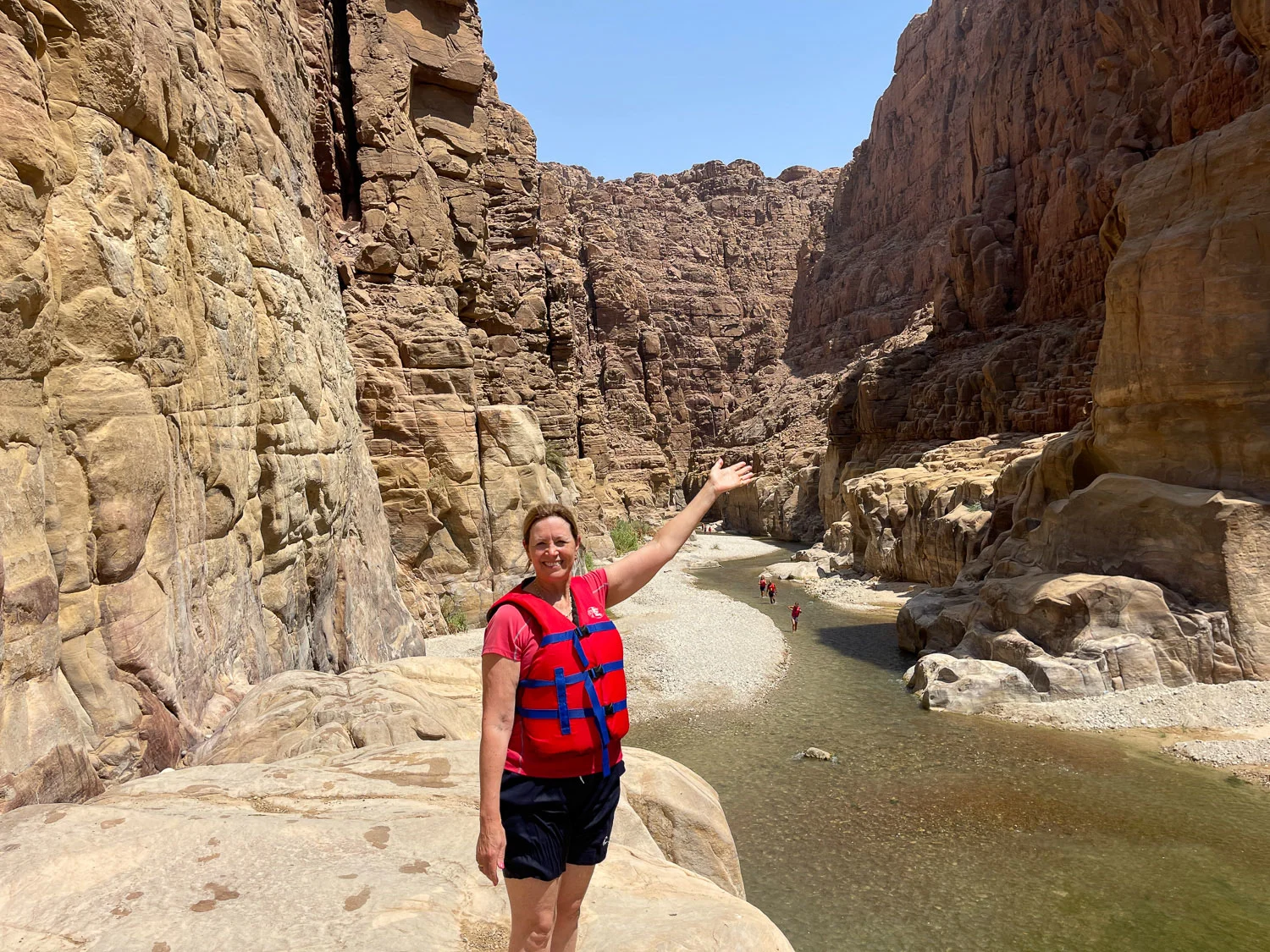
This article may contain affiliate links that provide commission on purchases you make at no extra cost to you. As an Amazon Associate I earn from qualifying purchases.
Wadi Mujib Biosphere Reserve
The Mujib Biosphere Reserve in Jordan was established in 1985, extending from the Dead Sea at 416 metres below sea level, to the Karak and Madaba mountains at 900 metres above sea level.
Covering an area of 212 square kilometres, the variety of elevation, combined with the year round supply of water, creates an area rich in biodiversity. Sandstone cliffs are home to the rare horned Ibex, as well as providing a protected haven for many other mountain animals and birds.
The clear waters of the Mujib and Hidan rivers flow through gorges, with waterfalls and cascades feeding pools that offer exciting and adventurous activities. Most visitors come for the Wadi Mujib canyoning experience, the majority undertaking the self-guided Siq Trail from the Wadi Mujib Adventure Centre.
The reserve and the activities within it, are managed by the Royal Society for the Conservation of Nature, under its trademark organisation Wild Jordan.
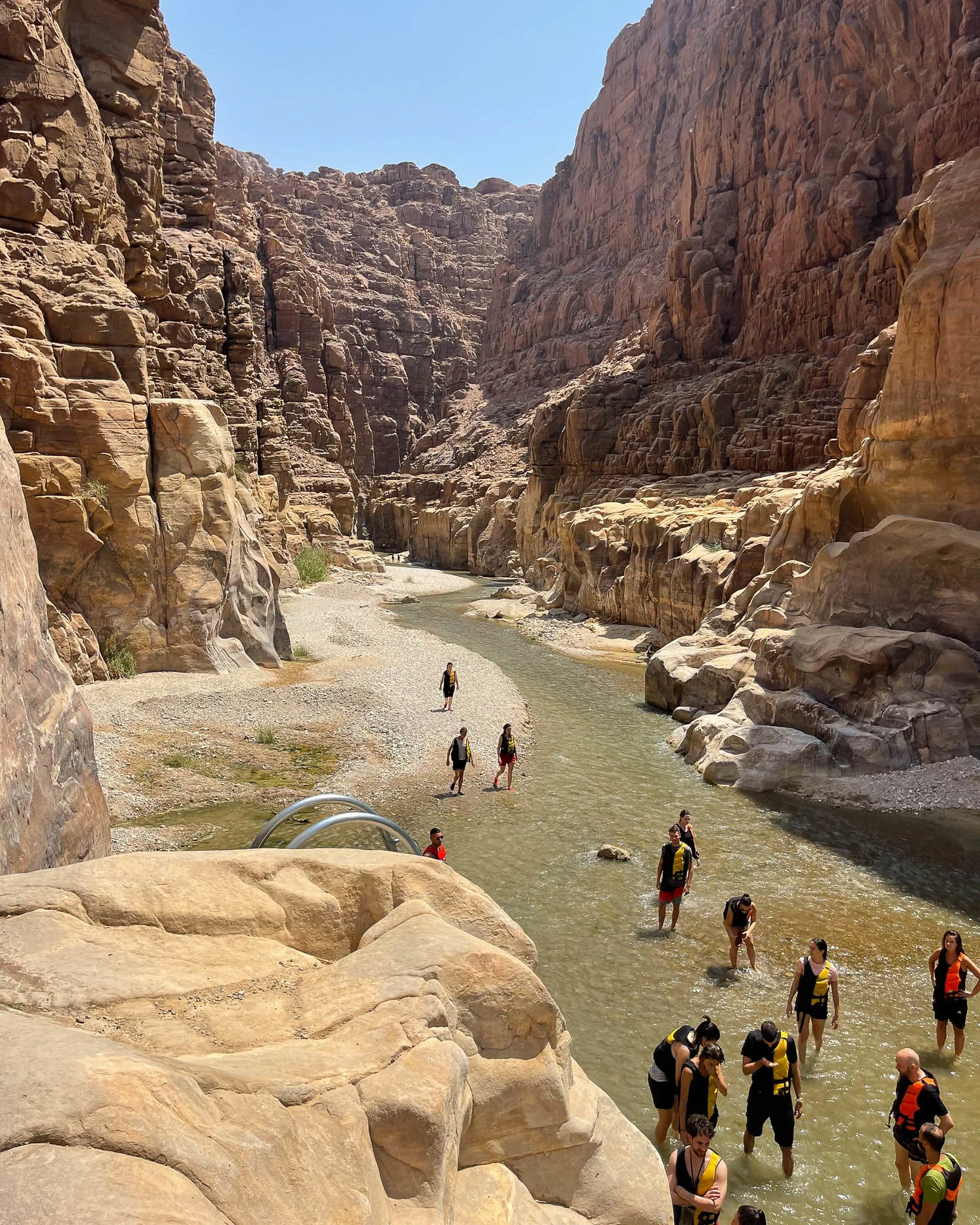
Hiking trails in Wadi Mujib Biosphere Reserve
There are set hiking trails within the Wadi Mujib Biosphere reserve, the most popular of which is the self-guided Siq Trail. Other trails are more adventurous extensions of the Siq Trail, that must be undertaken with a guide.
These start at the Wadi Mujib Adventure Centre, but it’s worth knowing that there’s a second Hidan Adventure Centre, that runs even more adventurous canyoning experiences.
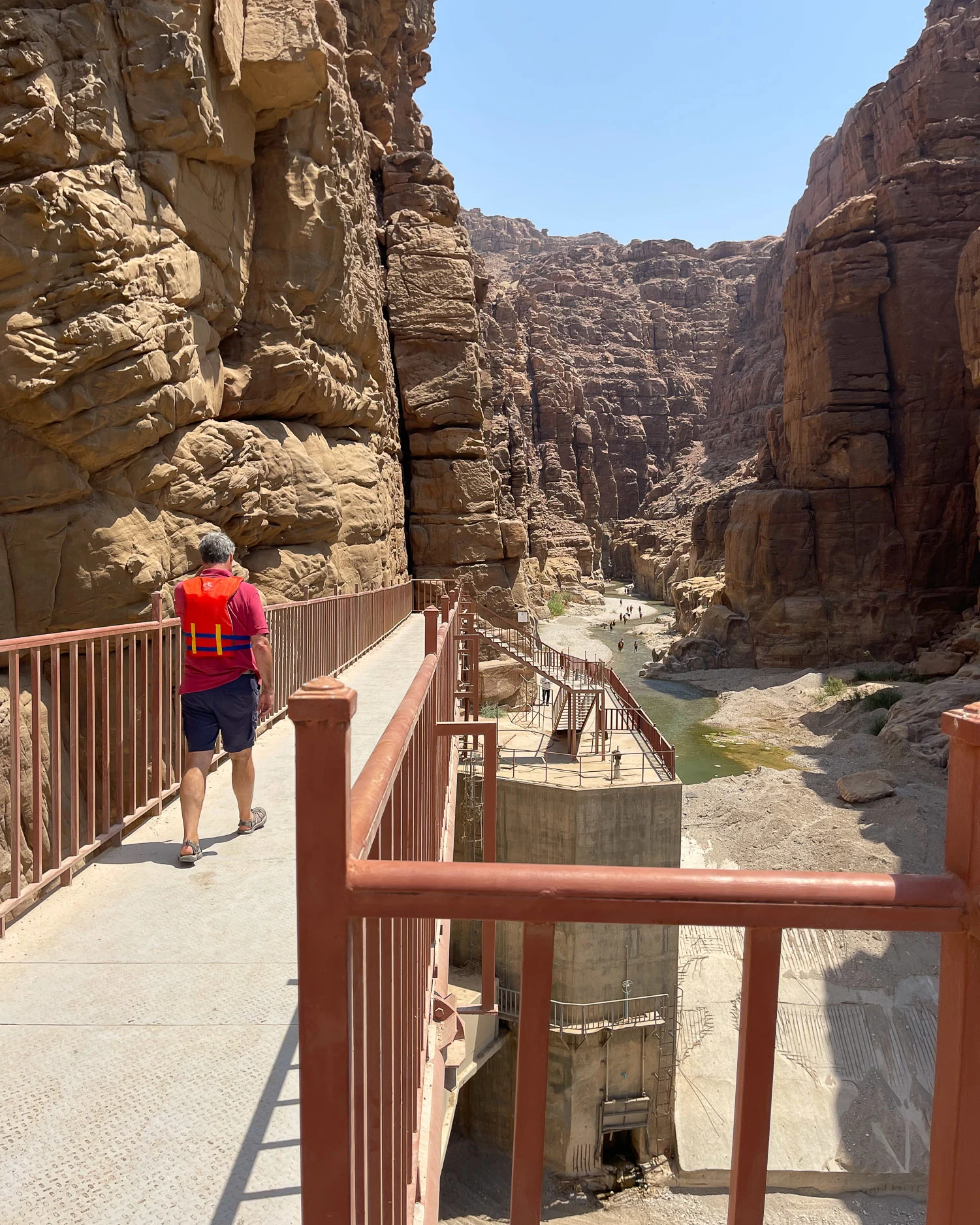
Siq Trail at Wadi Mujib
The Siq Trail at Wadi Mujib is the most popular ‘wet’ trail, since it’s the only one you can make as a self-guided hike. You’ll walk through a canyon, wading through the fast flowing river over pebbles. Within the gorge there are three main cascades, which you’ll need to climb with the help of ropes and a metal ladder.
After the third cascade, a further wade along the river brings you to a waterfall cascading into a natural pool where you can swim. You then return by the same route, and at some cascades will need to slide over them under the guidance of the guides.
- Start: Wadi Mujib Adventure Centre
- Timing: April-October only. Open 8am with last entry 3pm
- Distance: 2.5 km
- Time to hike: 2-3 hours
- Capacity: 100-150 people
- Difficulty: easy to moderate depending on the water levels
- Self-guided
Our experience on the Siq Trail at Wadi Mujib
We visited Wadi Mujib in August, as a stop off on our drive from Petra to the Dead Sea, where we were to spend a couple of nights. It was around lunchtime when we arrived and luckily the car park was not too full to find a space.
We bought a ticket, then changed in the visitor centre toilets, locking all our belongings in our hire car. Although the lockers were not operational, we were able to leave our money, passports and car keys in a bundle behind the ticket desk.
Discover the best things to do in Petra, Jordan – plus itinerary ideas
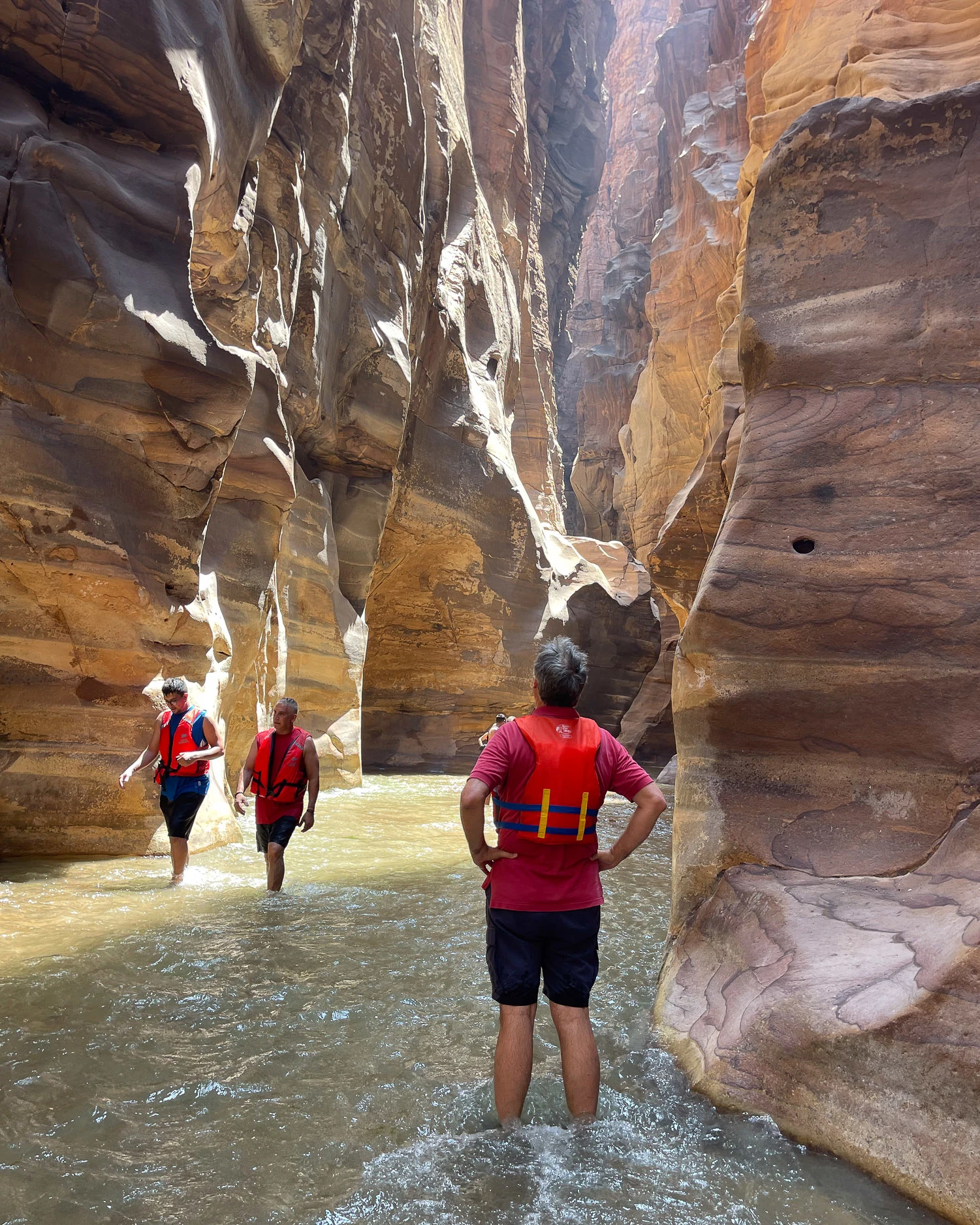
Having chosen our lifejacket and hired a drybag for my phone, the first hurdle was to climb down the metal ladder to the riverbed. We waded up the river, which in high summer seemed relatively low, compared to reports we had heard of it being waist or chest deep at other times of year.
Up until the first cascade, we were knee deep in water with dry sections of river bed on either side. Although the temperatures were high (around 36 degrees celsius), the soaring walls of the canyon and the constant flow of water kept us refreshingly cool.

Need help to design your dream holiday to Jordan? We’ve partnered with UK travel advisor Luxeco Holidays to create your personalised itinerary
The cascades at Wadi Mujib
After 20-30 minutes, we arrived at the first and easiest of the cascades. To one side was a rope and obvious footholds to pull yourself up.
It was a bit tricky knowing where to put our feet, but we made it and a helpful local (read more about this later) gave us a hand and took a photo of us at the top of the cascade.
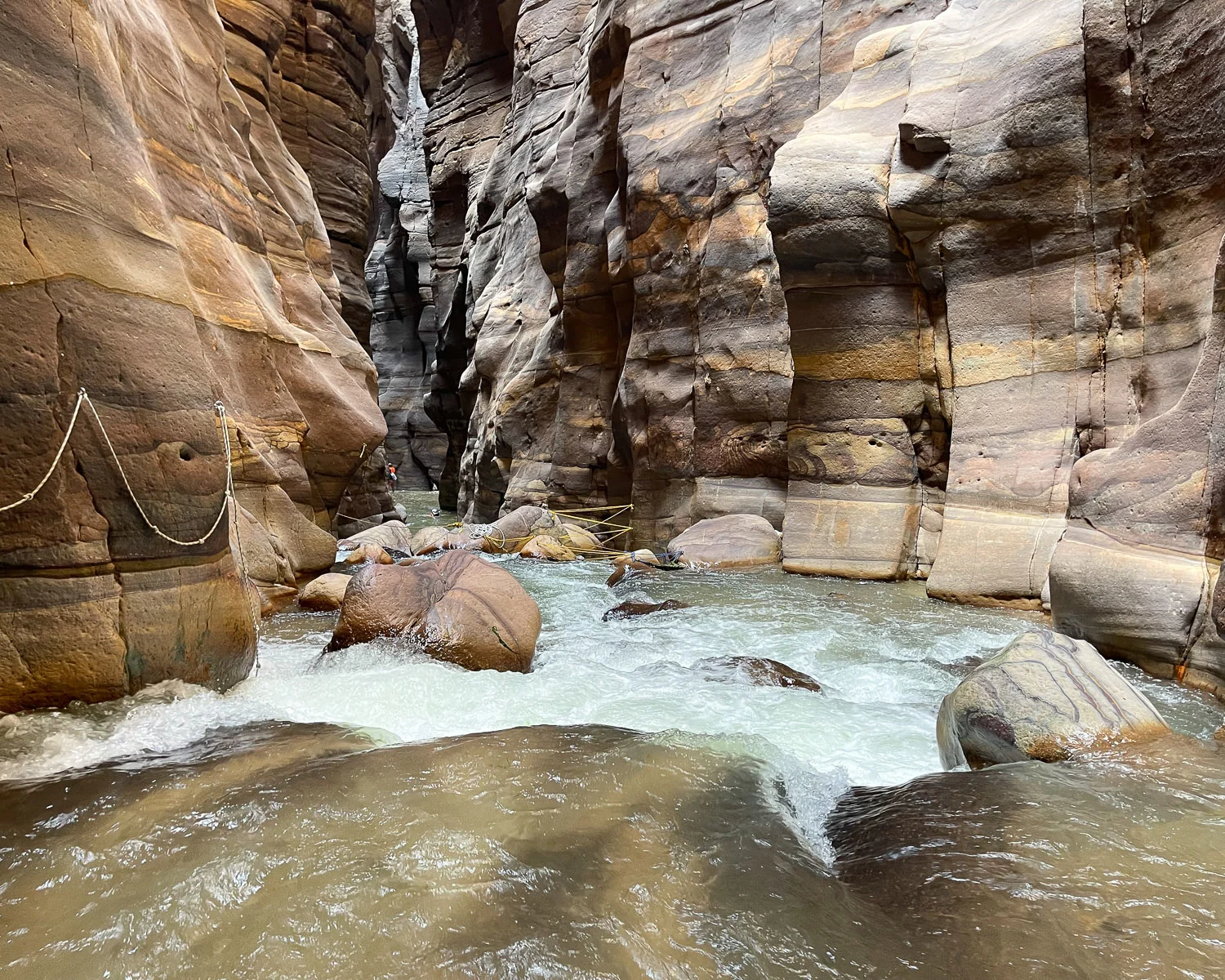
The second cascade of the Siq trail
A further wade up the river brought us to the second cascade, which was a little more challenging. The ascent was on a metal ladder, with a rushing torrent of water coming over it.
With the flow of water being pretty strong, we had to hold our breath and ascend by feeling our way for part of it, since the water flow completely covered us.
A guide was sitting at the top of this second cascade, controlling the flow of people. Although a bit of a queue had developed, we didn’t have to wait too long.
To descend this waterfall, most people walked back down the ladder, jumping off at the end. There was also a route to slide down, although we didn’t see many people using this as perhaps the water was not high enough.
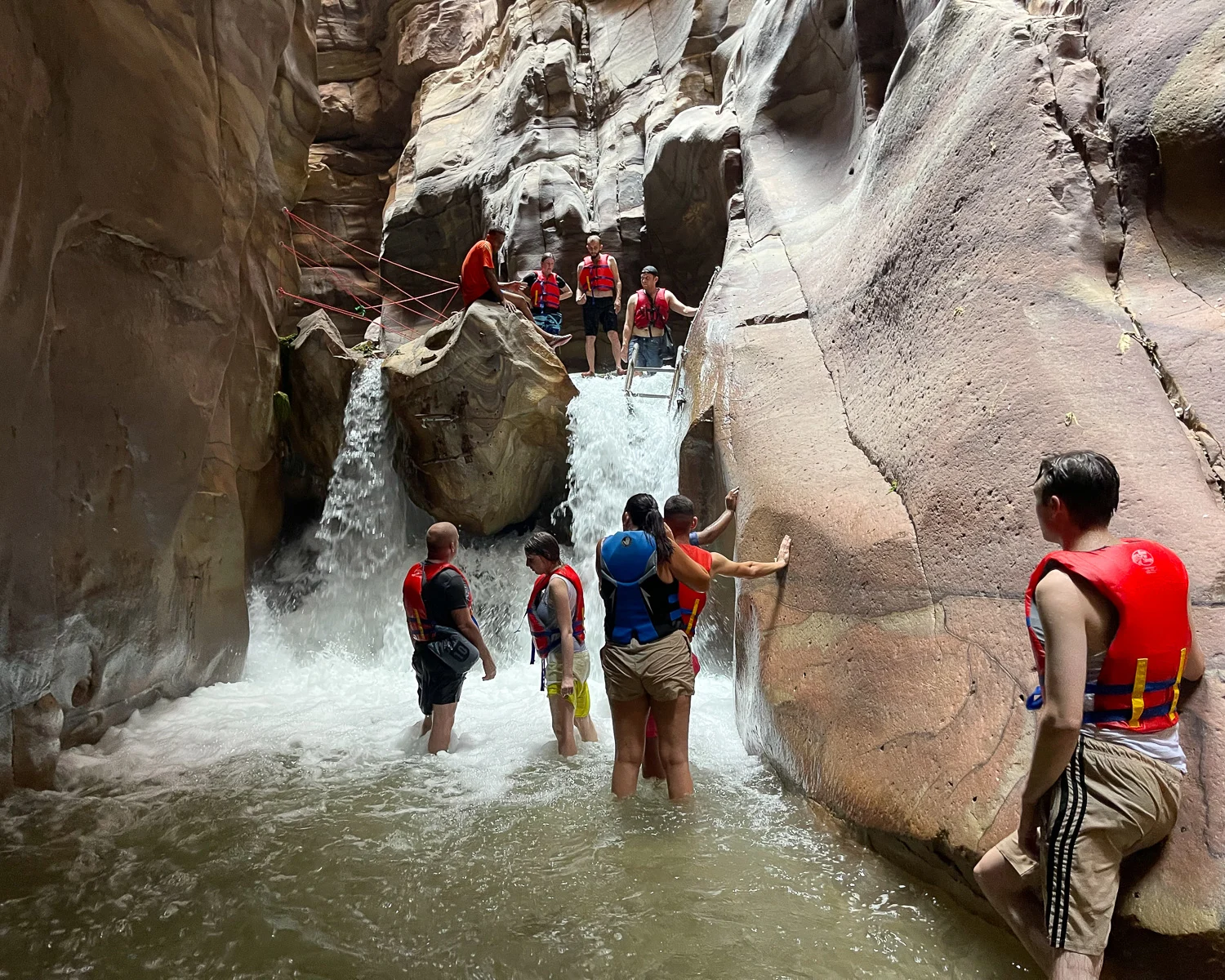
The third cascade of the Siq trail
Having navigated the second cascade successfully, we continued to the third and final cascade. Here we didn’t see any guides in attendance, but our ‘helpful local’ encouraged us on, offering to help. We decided to hold back and watch as a couple of fitter travellers climbed the metal ladder, with a scramble over a boulder at the top.
Beyond this, we knew was a large pool and the final 20 metre high waterfall. However, having watched others trying this third cascade, we decided we’d reached the limit of our comfort zone and decided to make our way back.
On the return, it was very refreshing to descend the cascades and drift along with the current, even though the water was a bit shallow to take us the whole way without wading.
We felt elated that we’d completed at least the first two cascades, and in the heat of August enjoyed the cool of the river water.
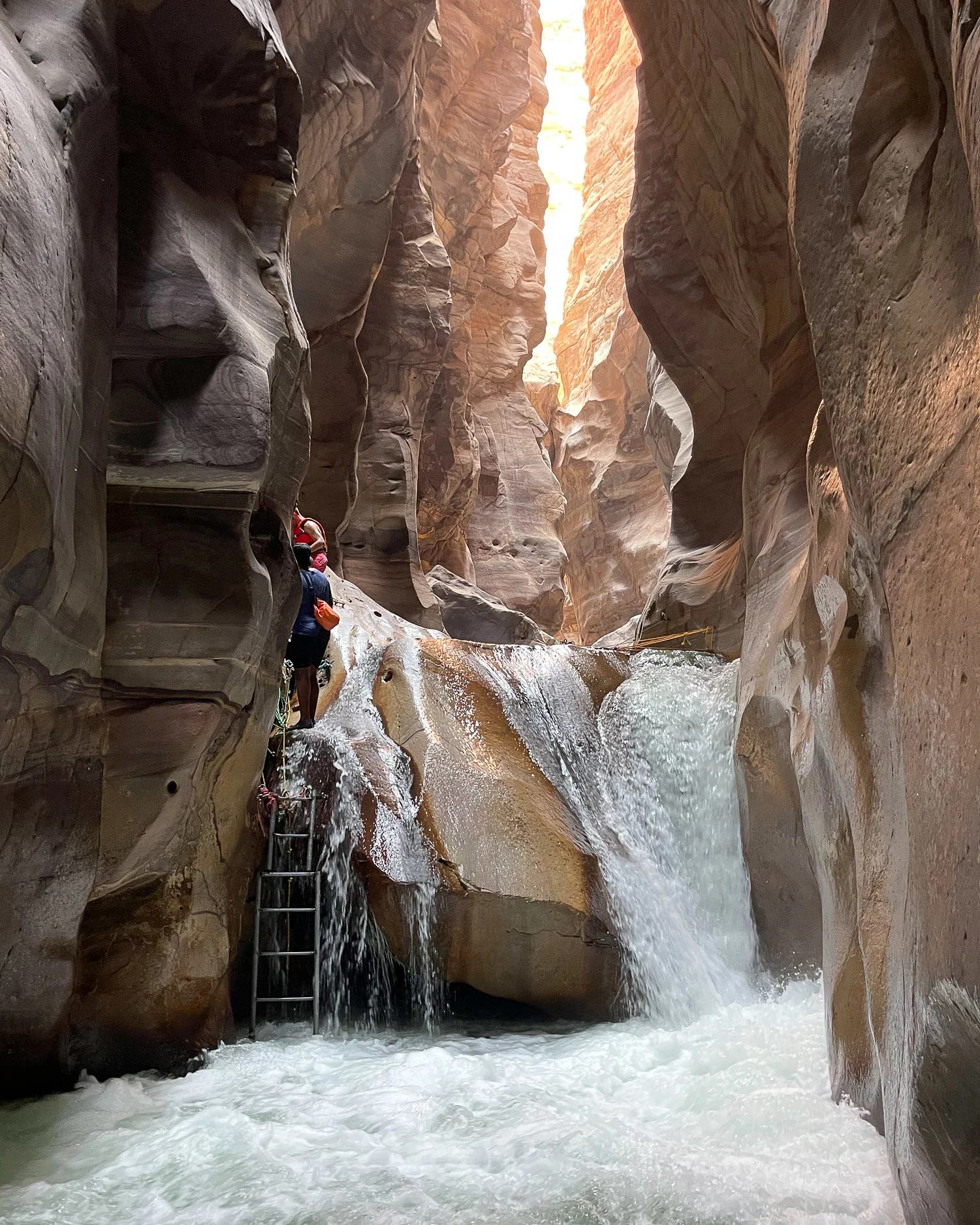
More trails at Wadi Mujib
Canyon Trail
This guided trail is for the more adventurous, although it was closed when we visited. Starting at the Wadi Mujib Adventure Centre, you follow the Dead Sea Highway South and then climb uphill on a rocky trail to reach the Mujib river.
Following the river will bring you to the top of the waterfall at the end of the Siq trail. You’ll descend the 20 metre high waterfall with the help of the guide and then return along the Siq trail in reverse, ending back at the Visitor Centre.
- Start: Wadi Mujib Adventure Centre
- Timing: April-October only. Starts 8.30am
- Distance: 4 km
- Time to hike: 4 hours
- Group size: 6-25 people
- Difficulty: moderate to difficult
- Guided
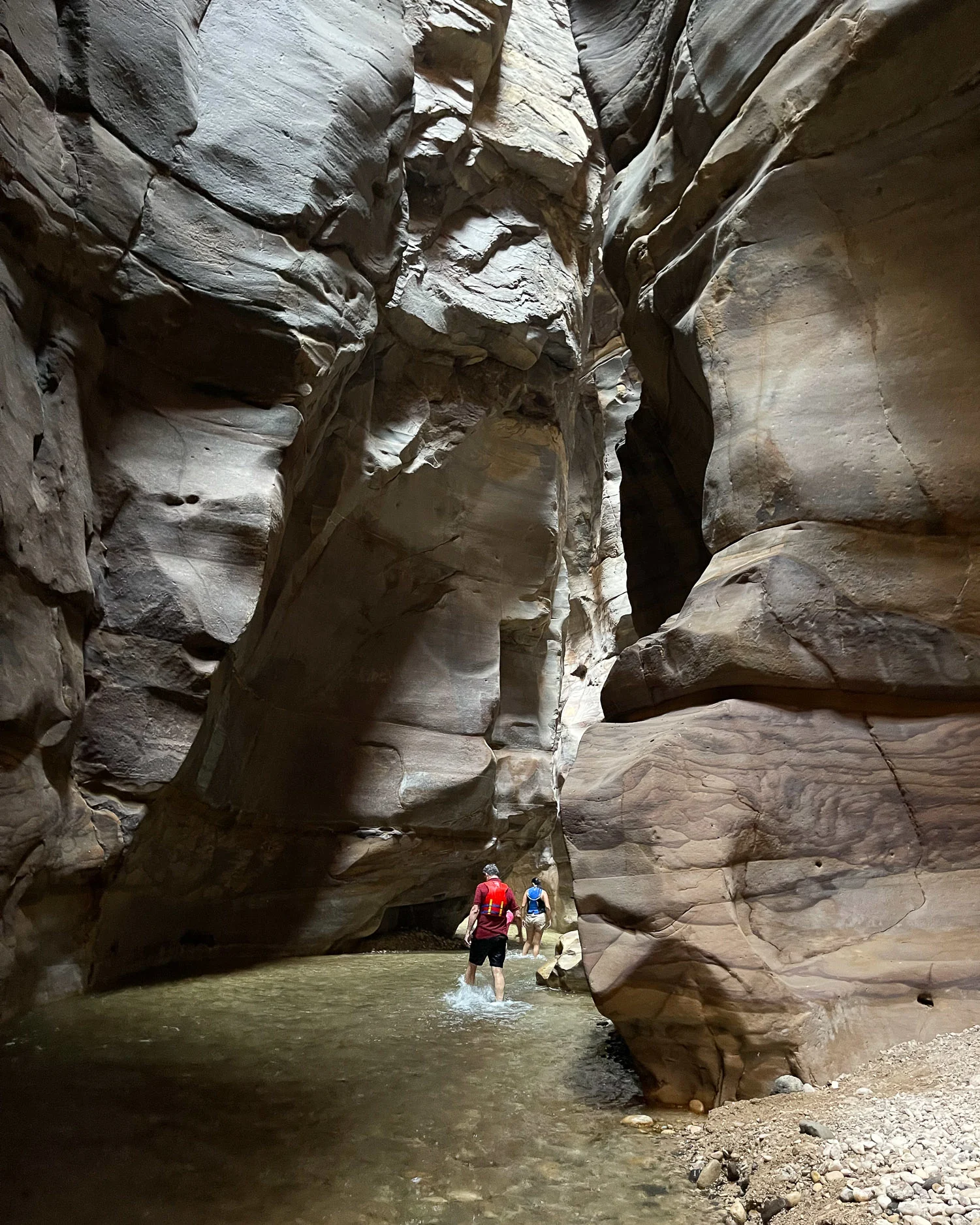
Malaqi Trail
This trail was closed when we visited and is a longer version of the Canyon trail. Once you reach the Mujib river you hike along it upstream to reach the confluence with the Hidan river. Here are some natural pools where you can swim.
Returning along the Mujib river, you descend the 20 metre high waterfall and follow the Siq trail back to the Visitor Centre.
- Start: Wadi Mujib Adventure Centre
- Timing: April-October only. Starts 8.00am
- Distance: 6 km
- Time to hike: 5-6 hours
- Group size: 6-25 people
- Difficulty: moderate to difficult
- Guided
Map below showing Wadi Mujib trails taken from Wild Jordan leaflet
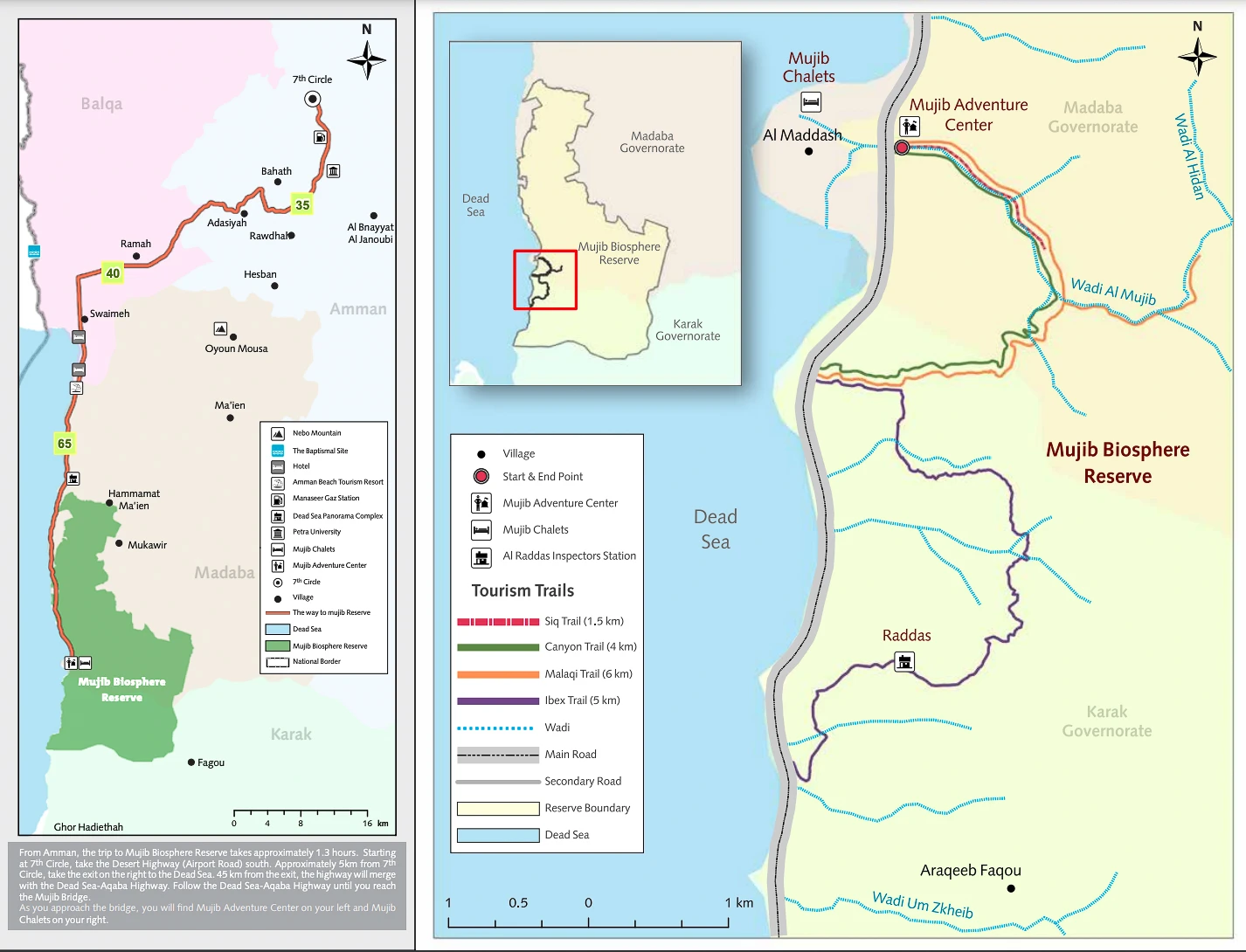
Ibex Trail
This ‘dry’ trail is only hiked in winter as a guided group activity. The trail ascends from the Dead Sea Highway into the reserve, running parallel to the Dead Sea, which you can see during the hike.
You’ll continue along some dry riverbeds, where you may see the horned Ibex that are protected within the reserve. After visiting the rock ‘statue’ of Lot’s wife, the hike brings you back to the Visitor Centre along a road for the last hour.
- Start: Wadi Mujib Adventure Centre
- Timing: November-March only. Starts 8.30am
- Distance: 5 km
- Time to hike: 5-6 hours
- Group size: 6-25 people
- Difficulty: moderate
- Guided
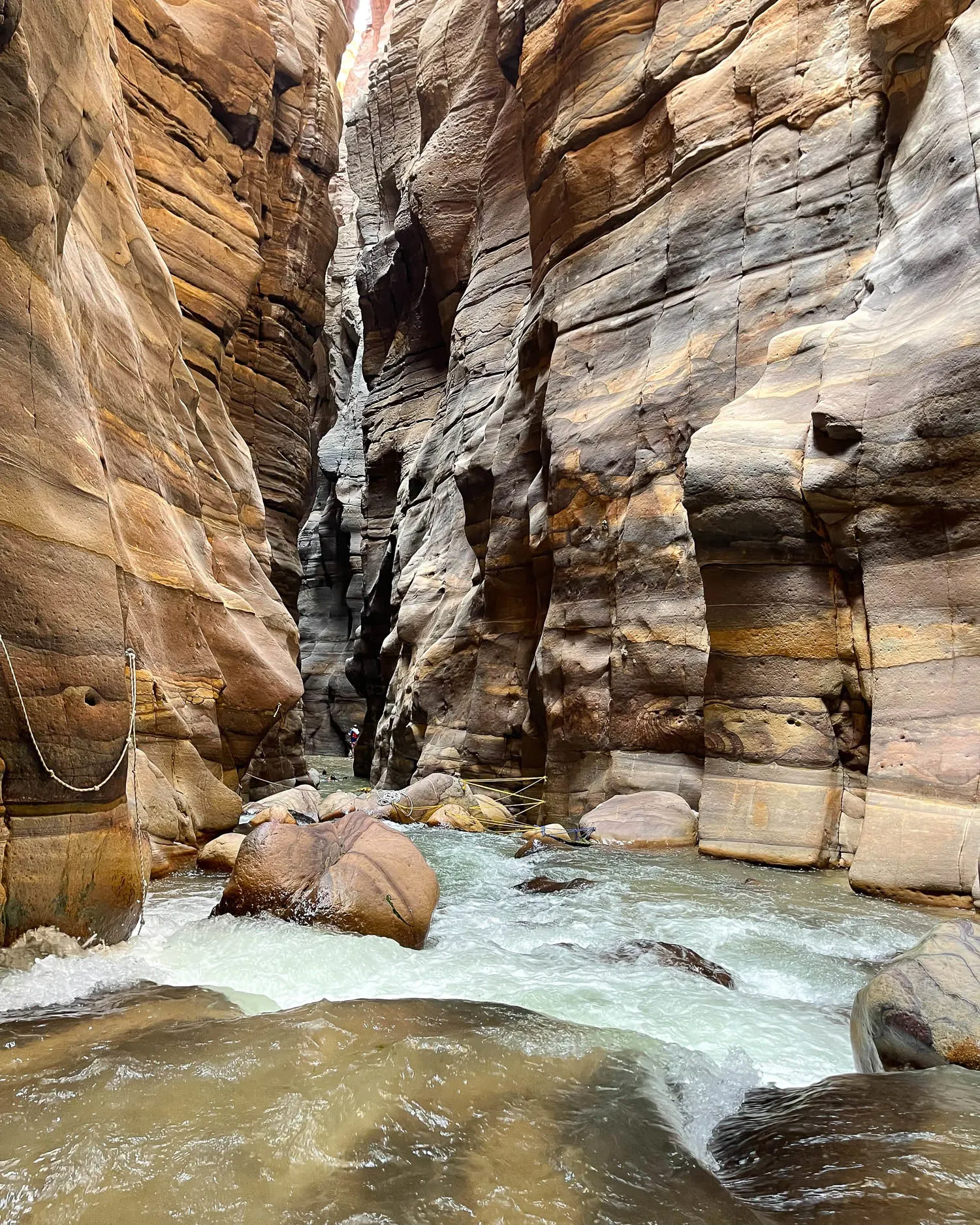
Hidan Adventure Centre
It’s worth knowing that there’s a second adventure centre located within the Wadi Mujid Biosphere Reserve, located in the upper part of the Wadi Mujib Biosphere Reserve, around an hour’s drive from Madaba. On the map it’s marked as al-hidan adventure centre and is signposted from Madaba.
The Hidan river valley has a permanent fresh water supply and offers an adventurous trail with natural pools and waterfalls. You should check with Wild Jordan before arriving and book this trail in advance as it may not run all the time.
Al-Hidan trail
This is a tough and adventurous guided trail, following the river through natural pools. You’ll be required to climb up waterfalls and cascades against the flow of the water, or jump or abseil from the rocks into the water. The trail ends at a water mill, where transport is provided for the return trip back to the Adventure Centre.
- Start: Hidan Adventure Centre
- Timing: April-October only. Timing 8.30am – 3pm
- Distance: 5 km
- Time to hike: 3 hours
- Group size: 5-20 people
- Difficulty: moderate
- Guided
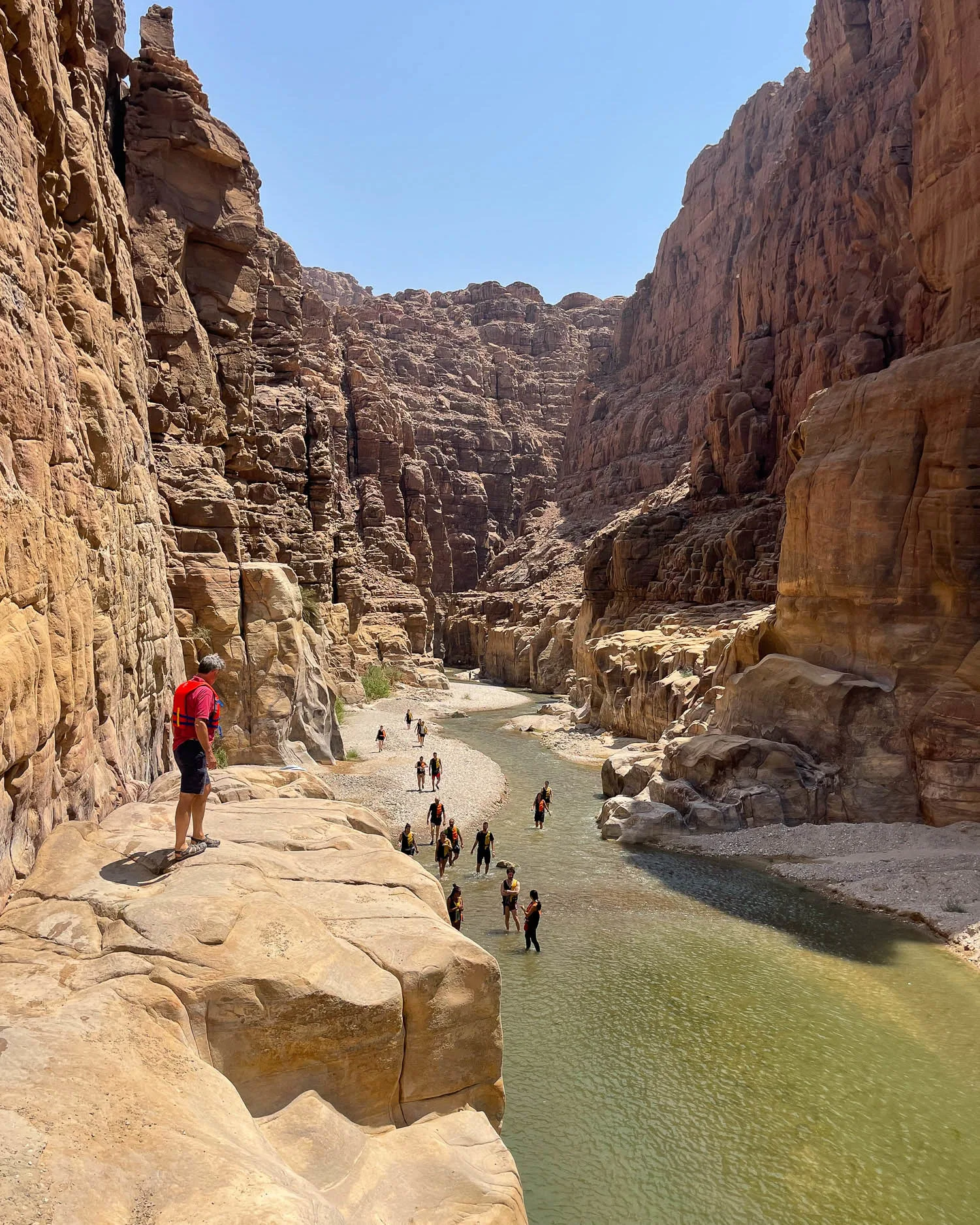
Other activities in Wadi Mujib Adventure Centre
There are some other adventure activities on offer at Wadi Mujib. However they did not seem to be running in August when we visited, so we were not sure if these are seasonal activities. It’s best to check in advance with Wild Jordan and take a guide where necessary.
Rock climbing at Wadi Mujib
There are 3 rock climbing routes close to the Wadi Mujib Adventure Centre of easy to moderate level. The routes are 10-15 metres high and set up for top rope climbing or lead climbing. Check in advance with Wild Jordan, to see if these climbing routes are open.
Zipline at Wadi Mujib
The zipline with two parallel cables allows two people to zipline at once. The cables run across the gorge close to the Wadi Mujib Adventure Centre, parallel with the Al Mujib bridge. Check in advance with Wild Jordan, to see whether the zipline is open, as we did not see it running when we were there.
Flora and fauna to look out for at Wadi Mujib
The Wadi Mujib Biosphere Reserve is a staging point for migratory birds such as white storks and Levant sparrows. At least nine species of birds of prey are known to breed in the reserve including the Little Owl and Long-legged Buzzard.
You probably won’t see birds in the canyon, but are more likely to see them with a guide on the ‘dry’ trails in other less visited parts of the reserve.
The reserve is also home to the rare Nubian Ibex, a large mountain goat that was the symbol of the Moon god in ancient times. A captive breeding programme has brought the Ibex back from the brink of extinction, and there are now around 90 Ibex within the Wadi Mujib reserve.
The best way to see the Ibex is on a winter hike on the Ibex Trail, guided from the Wadi Mujib Adventure Centre.
Tickets for Wadi Mujib
Tickets for the trails are sold in the Wadi Mujib Adventure Centre. Entry fees for the Siq Trail are 22 JD for non-Jordanians, 16 JD for Jordanians and 19 JD for residents.
Entry fees for the dry Ibex trail that you can hike in winter is 21 JD for non-Jordanians, 12 JD for Jordanians and 17 JD for residents. The cost includes taxes and a guide is included for the Ibex (dry) trail but not for the Siq (wet) trail, which is self guided.
Both cash and cards were accepted to pay for tickets. However, when we hired a drybag they would only accept cash.
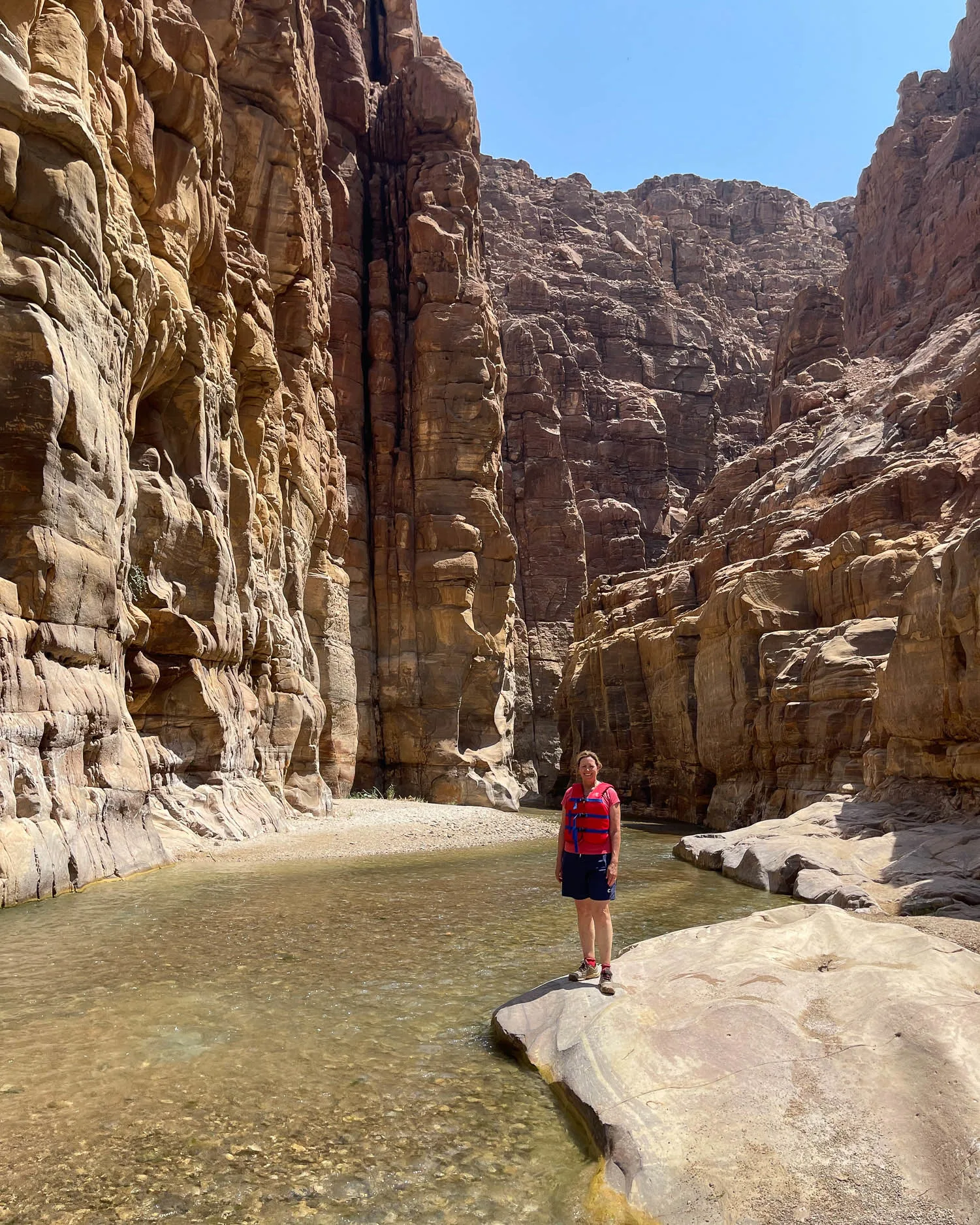
When is Wadi Mujib open?
The Wadi Mujib Adventure Centre opens at 8am and last entry for the self-guided Siq Trail is 3pm. The timing of starting the trail may also be determined by the limit of the Siq trail to 100-150 people.
So if the maximum of people has already entered the trail, you may have a waiting time of up to 2 hours before you can start. Other guided hiking trails tend to start at 8.00-8.30 am from the Wadi Mujib Adventure Centre.
Best month to visit Wadi Mujib
You are limited by the fact that the water trails such as the Siq at Wadi Mujib are only open in the summer months from 1 April to 31 October. This can also be variable, depending on weather conditions and water flow.
If there is too much water and conditions are too dangerous, the whole trail will be closed, so it’s best to check in advance on the Wild Jordan Website or social channels.
Bear in mind that the water flow is highest in the spring and early summer after winter rainfall. Water levels drop through the summer and early autumn until the rains start again.
When we visited in August the water was mostly knee or thigh deep, but at other times of year, you could be swimming through chest or neck deep water.
In winter, the dry Ibex trail is available for a guided hike between 1 November and 31 March.

Need help to design your dream holiday to Jordan? We’ve partnered with UK travel advisor Luxeco Holidays to create your personalised itinerary
Which day is best to visit Wadi Mujib?
While the month of your visit will likely be determined by other factors, you can at least try and plan to visit on a day when you’ll get the least crowded experience. Bear in mind that the Jordanian weekend is Friday and Saturday, when the Siq Trail will be busiest with local visitors.
In high season (May-June and September-October), at weekends and holiday periods when the trail will be busy, it’s best to arrive as early as possible in the day.
This will mean that the car park is not yet full and you won’t have to wait as long to get on the trail, which is limited to 100 people. If the trail is already full, you may be asked to wait up to 2 hours before starting the trail.
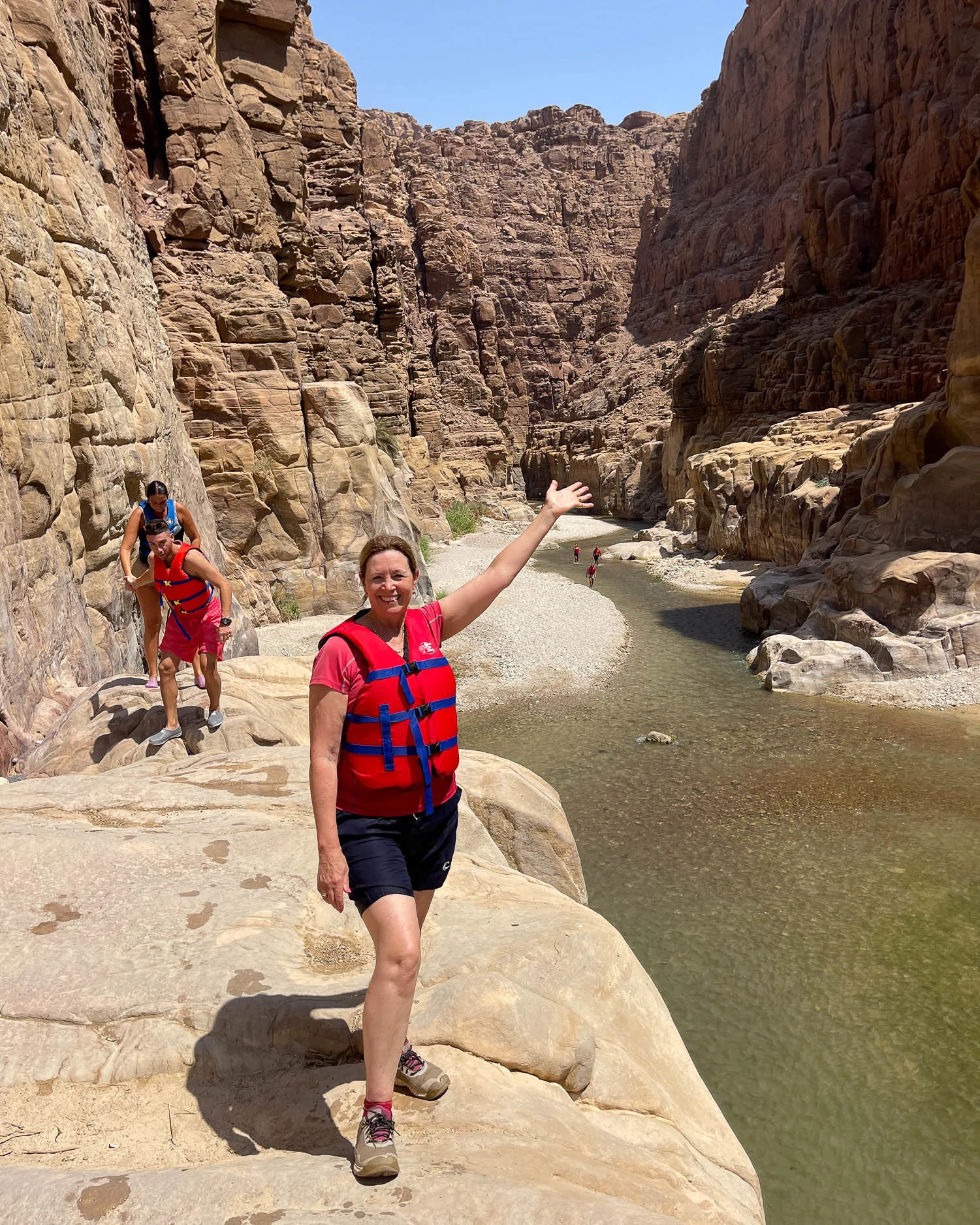
Photography at Wadi Mujib
The Siq trail of Wadi Mujib is a certainly a photogenic setting and you’ll probably want to take some photos to share with your friends. If you bring a mobile phone, Go-pro or regular camera, you’ll also need a drybag to carry it in.
You may also want to wrap your camera in some plastic bags or extra padding against knocks on the rocks. Unless you are a pro-photographer, we recommend leaving the big expensive camera behind and just use a mobile phone or small compact camera.
It’s quite easy to take photos at the start of the trail, when you are wading through water with dry areas of pebbles at each side of the river bed. Once you arrive at the cascades there’s a chance to take some photos, then pack the camera away, while you tackle the ladders and boulders to ascend each cascade.
In between the cascades and at the final waterfall you can find a secure spot and carefully take the camera out of the dry bag to take photos.
On the return journey you will come back the same way, but this time you may have to slide down the cascades under the direction of the guides there.
You’ll be submerged in pools below the cascade, so this is the time to make sure your drybag is completely watertight. Also be aware that your hands will be wet when using the camera.
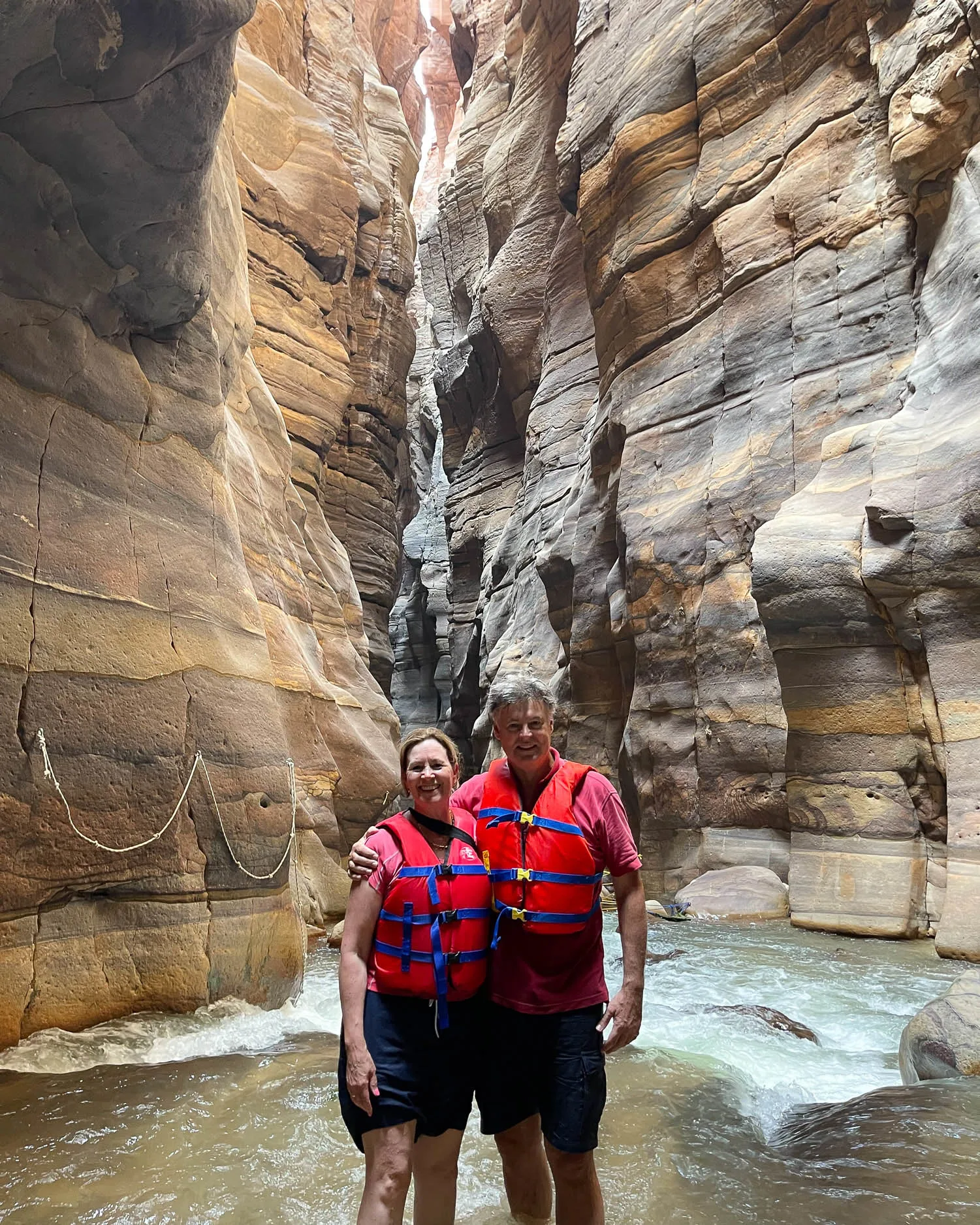
What to wear and bring to Wadi Mujib
The clothing advice below assumes that you are doing the Siq trail or one of the other wet trails. This is an adventurous canyoning activity, so you should dress accordingly. For ‘dry’ trails like the Ibex Trail you will not get wet, so can dress in normal hiking gear.
Clothing
We found that quick dry sports t-shirt and sports shorts or cutoff leggings were ideal, layered over a swimsuit. You need clothing that will be light when wet, yet protect you from scrapes against the rocks and metal ladders. Men can wear swimming shorts with a t-shirt for added protection.
Although Jordan is a Muslim country, this kind of sports clothing seemed the norm for both men and women at Wadi Mujib. Ladies, it’s better to avoid skimpy swimwear with nothing over it, as it won’t protect you against the rocks and could invite unwanted attention from local men.
If you have long hair, it’s better to tie it back against the rush of water when you go through the cascades.
Footwear
You’ll need to wear trainers, hiking sandals or water shoes that you don’t mind getting wet. They need to be fairly substantial and secure, as you’ll be walking on the river bed, clambering over boulders and up metal ladders. Do not attempt this in flip flops or slip on sandals that will be washed away at the cascades.
Guy found that his Keen hiking sandals were ideal and I used my Keen walking shoes, although they were a bit heavy when soaked in water and took ages to dry out. If you have water shoes that have a sturdy sole, these would also be ideal.
There are water shoes to rent at the Visitor Centre for 5JD, although we heard that they may not always have your size or may run out, so don’t rely on this.
Lifejacket
On the Siq trail and other wet trails it’s mandatory to wear a lifejacket. These are provided in the visitor centre just after the ticket desk and before you enter the trail. The lifejackets do come in different sizes, although the staff member just told us to help ourselves, so we didn’t realise this at the time. So take a little time to choose a lifejacket that’s correctly sized and comfortable for you.
Dry bag
If you want to take anything with you on the Siq trail, such as a mobile or camera, you must take a dry bag. Assume that everything you take will be submerged in water and potentially battered by rocks and waterfalls or washed away.
We rented a dry bag at the visitor centre for 10 JD (cash only) and used it to carry our phone to take photos. While our drybag worked fine, if you rent one do check it over carefully for holes or leaks and close it securely. It might be worth taking a waterproof ziplock bag for extra protection of any mobile phones.
If you want to come prepared, you can buy a 5L or 10L drybag with a body strap, which can be used for any adventurous or water activities.
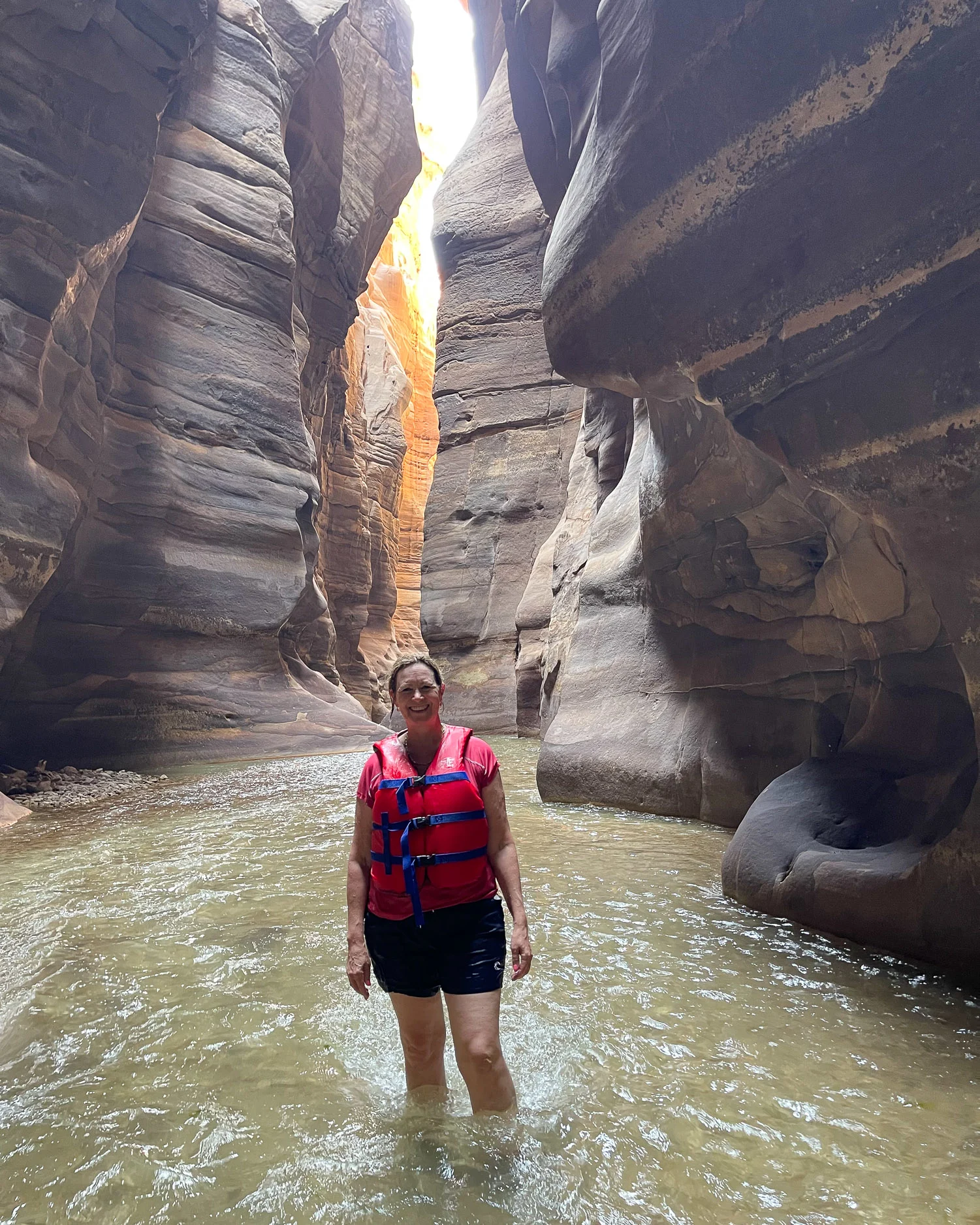
What to leave behind in a locker / car
This is what you should leave behind in a secure place, such as your hotel room or car if you are doing the Siq or other wet trails.
- Jewellery such as delicate necklaces, expensive gemstone rings or anything easily damaged, as it may get a battering on rocks or when climbing ladders or break and wash away.
- Water bottles unless you are prepared to carry them in a dry bag. Start the trail well hydrated and you should be fine for the 2 hours it takes there and back on the Siq trail, since you’re in a shady canyon. Don’t try to carry a water bottle in your hand as you need both hands free for climbing the cascades and it will wash away.
- Don’t pack food for the trail, as you can eat something before setting off or on your return in the cafe. Otherwise if you want to pack a snack like an energy bar, you need to put it in your dry bag.
- You don’t need a change of dry clothes on the trail. Leave these in your car and change once you are back in the visitor centre.
- Leave other loose items like sunglasses or hats behind as you’re in a shady canyon and they will get washed away.
- Your passport should stay in your hotel safe or locked in your car, as you don’t need it to buy tickets. However, if you are a Jordanian citizen or resident, you might need to show ID to get the reduced rate.
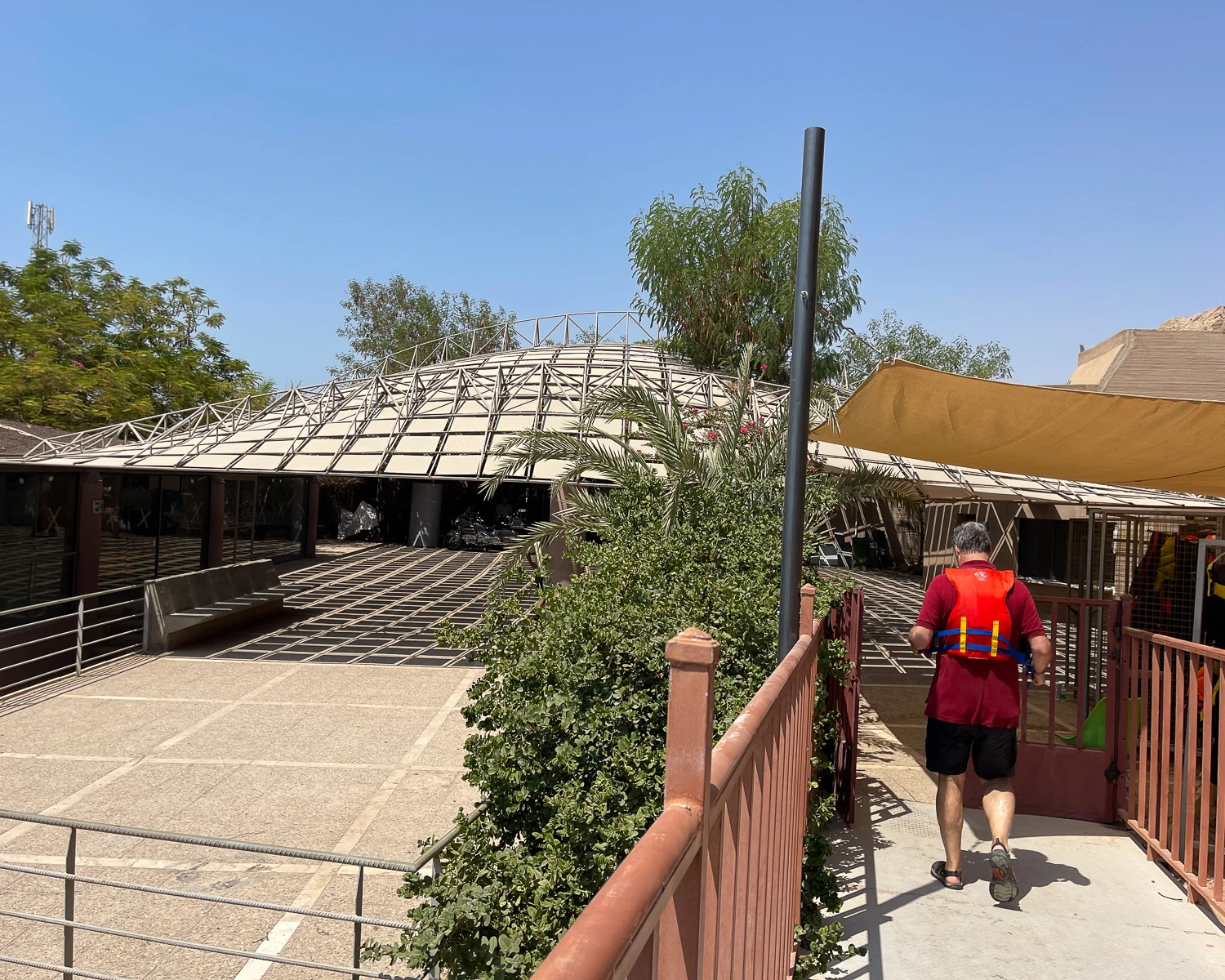
Facilities at Wadi Mujib Visitor Centre
The Wadi Mujib Adventure Centre is an attractive, modern facility with most of the facilities you will need. However, we did notice that not all services such as lockers or cafe were available or open.
Lockers and storage
We saw lockers at the Wadi Mujib adventure centre but they did not seem to be available or in use when we visited. This means that you’ll need to store anything you don’t take on the trail in your locked car.
Behind the ticket desk there were also small cubbyholes suitable to store a wallet or car keys, under the care of the staff there.
Food and drink
If you have a hire car, we recommend bringing some food and drink that you can consume before or after completing the trail. There’s a cafe at the visitor centre, but we weren’t sure if it was open when we were there. Also there were people smoking in the enclosed, air conditioned cafe area, so it smelt horrible.
We didn’t see any picnic areas near the visitor centre and the riverbed at the start of the trail is not ideal, since you need to climb down a ladder to reach it.
If you want to have a meal after the excursion, you may be better to drive 20-30 minutes north from the visitor centre to the Dead Sea commercial area where there are shopping malls, cafes and resort hotels.
Changing rooms and bathrooms
There are male and female toilets that have a changing area within them at the visitor centre. This was where most people seemed to change before and after taking the trail.
Wild Jordan Gift Shop
There was a very nice Wild Jordan gift shop within the visitor centre that was just opening when were were there. The souvenirs on sale were well designed and locally made, so this is a good place to buy souvenirs that support local businesses and communities.
Parking
The free parking area by the visitor centre holds around 40-50 cars, but we heard that it fills up quickly in high season and at weekends. There’s a small overflow section by the entrance, but once this car park is full it could be a problem, since you’re on the main Dead Sea highway, with no other obvious places to park. Therefore if you are visiting at a busy time, it’s best to arrive early in the day, in order to find parking.
Where is Wadi Mujib?
Wadi Mujib Biosphere Reserve is located in the western part of Jordan, close to the Dead Sea. The Wadi Mujib Adventure Centre is a 85 km (1 hr 15 mins drive) from Jordan’s capital Amman, or 240 km (3 hrs drive) from the Red Sea resort of Aqaba to the south.
Most international travellers fly into either Queen Alia International Airport for Amman or King Hussein International Airport for Aqaba. From these cities, Wadi Mujib is best combined with a visit to the Dead Sea resorts of Jordan. Wadi Mujib is also an easy drive from major tourist sites such as Petra, Wadi Rum and the historic town of Madaba.
If driving, take care to put “Wadi Mujib Aventure Centre” into your mapping tool, which takes you to the visitor centre close to the Dead Sea on the Route 65 Jordan Valley Highway / Dead Sea Highway. We read that there is also Wadi Mujib Dam which is located high in the hills, so take care that you don’t navigate there by accident.

Getting to Wadi Mujib
If you visit Wadi Mujib Adventure Centre independently, you can get there in a number of ways.
- Perhaps easiest is to hire a car from either of the two international airports, then include Wadi Mujib in a circular tour of Jordan that takes in the other major highlights, such as Petra, Wadi Rum and the Dead Sea.
- Unfortunately there are no public bus options that we could find to Wadi Mujib.
- If you are staying at one of the Dead Sea Resorts, your hotel can easily arrange a taxi transfer to Wadi Mujib, which is a 20-30 minute drive from most of the resorts. Try to arrange a driver who will wait for you while you do the Siq Trail, so that they can look after your belongings, in case the lockers are not operational.
- If travelling independently but without a car, you are perhaps better to join one of the excursions that can be arranged from Amman. We’ve given some examples below, or enquire at your hotel for tour recommendations.
Guided tours for Wadi Mujib
Wadi Al Mujib Adventures from Amman and other locations: This private tour includes pickup from your hotel in Amman or other locations, transport to the Wadi Mujib Adventure Centre where you undertake the Siq Trail alone, before the transfered back to Amman. The whole trip is around 5 hours.
Wadi Mujib Siq Trail with panoramic tour of Amman and optional Dead Sea Visit: This 5 hour tour includes pickup in Amman, transport to the Wadi Mujib Adventure Centre where you undertake the Siq Trail, then an optional visit to the Dead Sea beach where you can swim and take lunch.
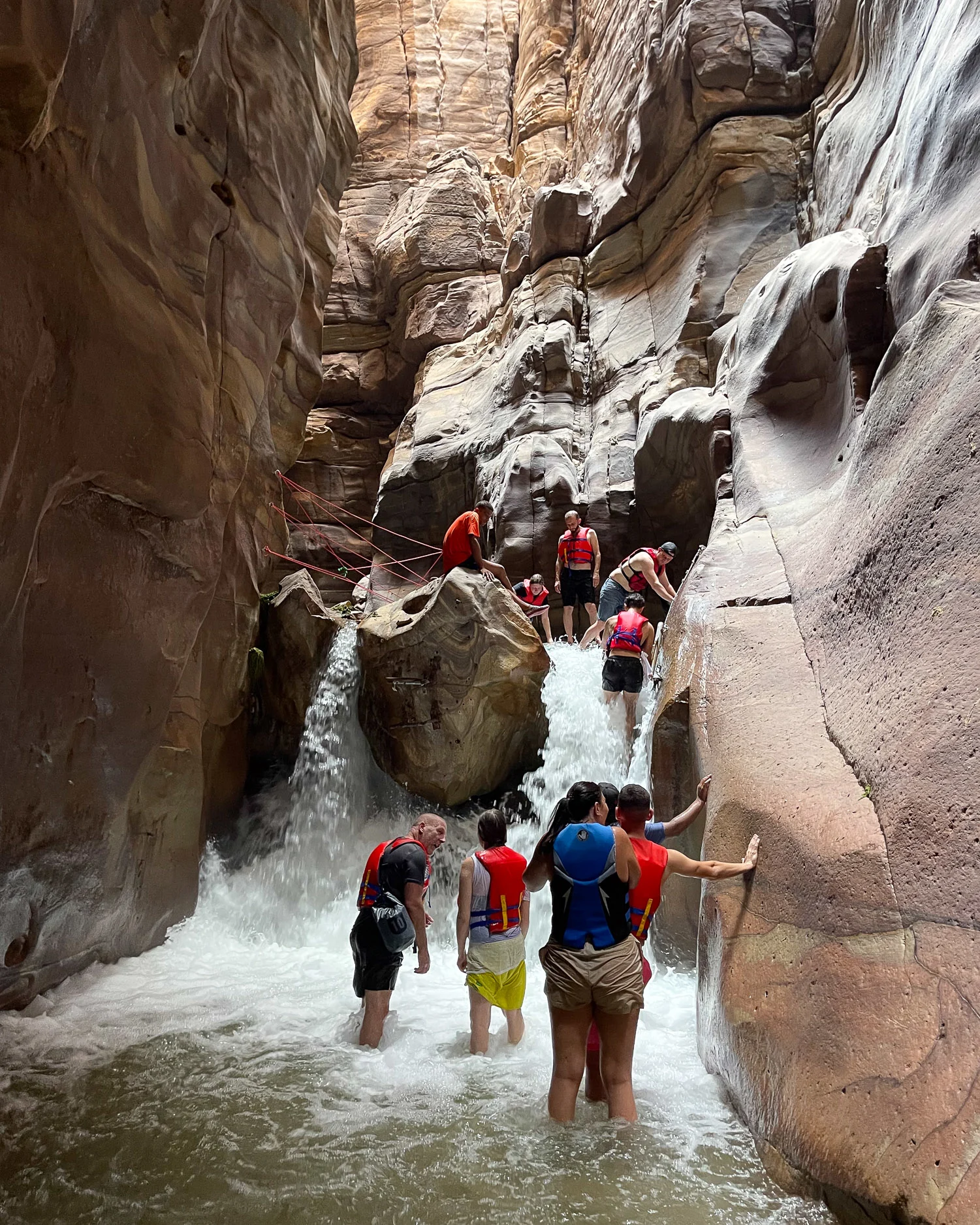
Safety at Wadi Mujib
Wadi Mujib is a showcase tourism attraction for Jordan and as such the general level of security is good. The trail is closely monitored by Wild Jordan and will be closed at times when the water level is too high or the conditions are dangerous.
However, do bear in mind that this is an adventurous activity, so you need to consider your own physical abilities before undertaking the Siq trail, which is self guided.
While life jackets are provided and are mandatory, there are no helmets provided. We would expect helmets to be mandatory at any similar adventure or canyoning activity in Europe.
We also felt that calling the Siq trail ‘self-guided’ is a bit misleading. True that you do not need to pay extra to hire a guide, unlike all the other trails. However, there are three major cascades, where you need to climb up ladders or scramble over boulders to ascend them and slide down the rocks to descend them.
We felt that in the interests of safety, there should be at least one guide at each of the cascades to help people and monitor safety. However we only saw one guide at the second of the three cascades. It seemed to us that the lack of guides at potentially dangerous points, combined with no helmets, could be an “accident waiting to happen”.
Unless you are experienced in this kind of adventure activity, I wouldn’t recommend taking this trail on your own, but rather go with at least one other person. This particularly applies to solo female travellers, who may find themselves targeted for unwanted attention from local men or guides.
If you have an accident in the canyon, the nearest medical help is at the Wadi Mujib Adventure Centre.
Having said that, the cascades get gradually more challenging and there are ropes and ladders to help you climb them. So if you feel you have reached the limit of your physical ability, you can turn back at any time.
We decided not to tackle the final cascade leading to the waterfall as we were worried it would be too much. However, we still really enjoyed the trail and it was one of the big highlights of our Jordan trip.
Other concerns
We read mixed reviews about the guides at Wadi Mujib. Some online reviews mentioned guides that were disinterested or giving unwanted attention to women, although we didn’t personally experience this.
Our main observation was that there didn’t seem to be enough guides around the cascades to monitor safety – we only saw one in the whole gorge. We also felt that the guides should be more easy to identify, wearing an obvious logo or high visibility t-shirt.
The reason we mention this is that we were approached by a local man who we assumed was a guide at one of the cascades. He kindly helped us up the first cascade and took our photo at the top. We assumed that he was an official guide who was assigned to help everyone at that cascade.
Instead he followed us up the gorge, continually offering us help as if he was our private guide. As we started to feel uncomfortable with his attentions we let him go on and made our return back down the gorge, only to find that he had followed us.
We were not sure if this was a local man who hoped that he would get some tip at the end of the trail for helping us. Or was he was an official guide who was off duty or who should have been monitoring the gorge for everyone?
To prevent this slightly uncomfortable experience, and bearing in mind that this is a chargeable activity, we feel that there should be more official guides monitoring what is an adventurous and potentially hazardous canyoning experience.
We also felt that it should be made easier to distinguish the employees of Wadi Mujib Activity Centre from locals who may try to befriend tourists and scam them.
Don’t let these reservations put you off, we had a great time and just want you to be aware of these kinds of issues.
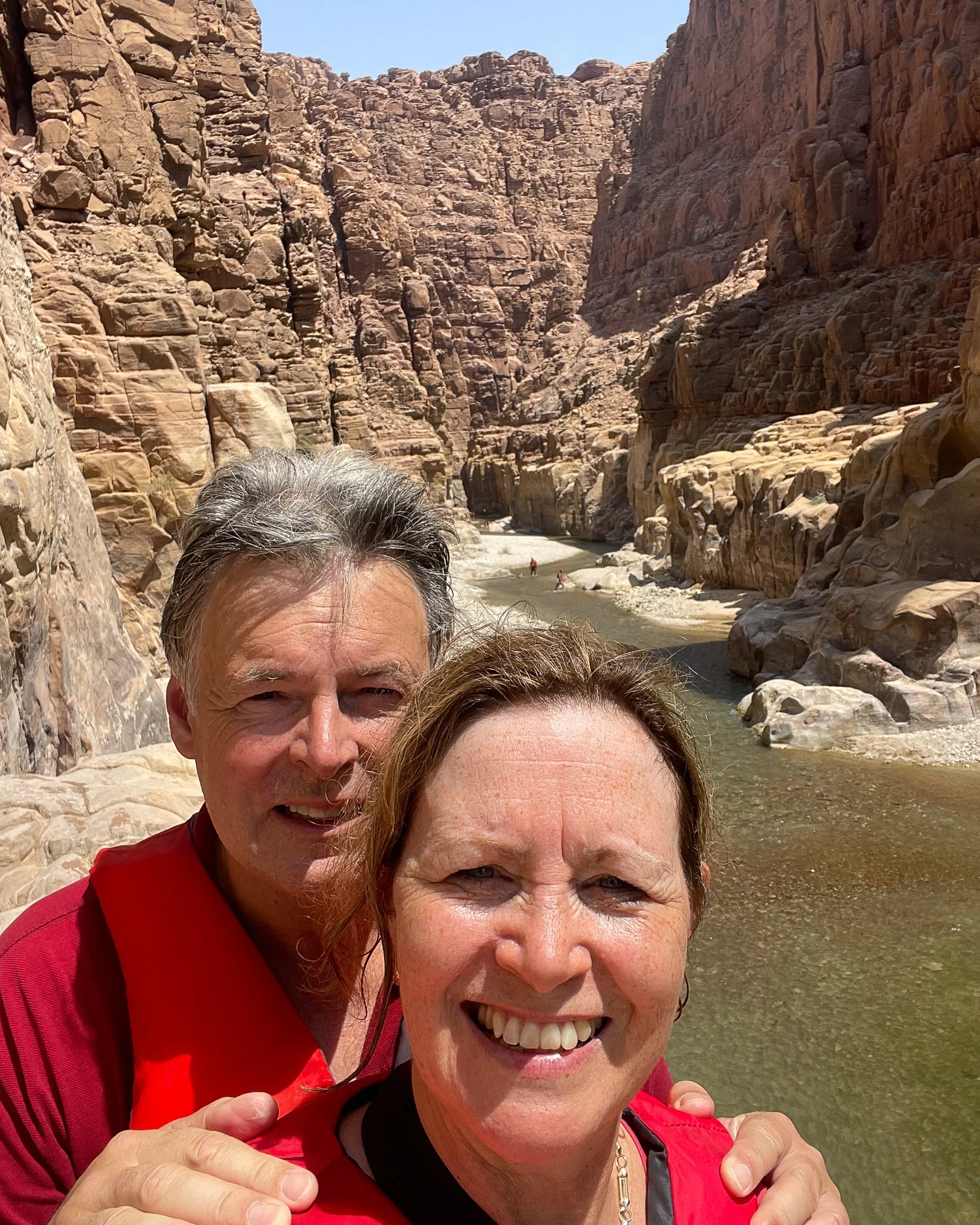
Who is Wadi Mujib suitable for?
- You need to be aged 18 or over in order to take the trail. ID may need to be shown for anyone who may not look 18.
- You need to be a swimmer, as while unlikely to be out of your depth, you may at times have to slide into pools and be fully submerged.
- We are fit and in our early 60s, and we very much enjoyed the trail, although we decided to miss out on the final cascade and waterfall, because it looked a bit too challenging.
- The Siq Trail is self-guided and suitable for most ages and abilities, provided you are reasonably fit and have good upper body strength. As the cascades get progressively harder, you can judge your own ability and turn back at any time.
- The other water trails (Canyon and Malaqui Trail )are guided and involve abseiling down a waterfall, before completing the Siq Trail in reverse. Therefore this is a true canyoning experience that’s best suited to the fit and adventurous traveller seeking in adrenalin thrill.
- If you would like to try the Siq Trail, but are worried about your ability, you could also enquire about hiring an individual guide at the Visitor Centre. This would much reduce the risk at the cascades, as you would have an experienced guide to give you a hand and show you the safest routes to navigate them.
Where to stay near Wadi Mujib
The closest place to stay to the Wadi Mujib Visitor Centre are the Wadi Mujib Chalets, which are run by Wild Jordan. There are 15 individual chalets, each with a double bedroom and bathroom.
The chalets are located are on the shores of the Dead Sea, with a private terrace to sit out or swing in your hammock. Steps lead down the stony slope to a place where you can swim (or more likely float around) in the Dead Sea.
There’s a communal restaurant that serves buffet style breakfast and evening meals. As the chalets are very popular they tend to book up well in advance.
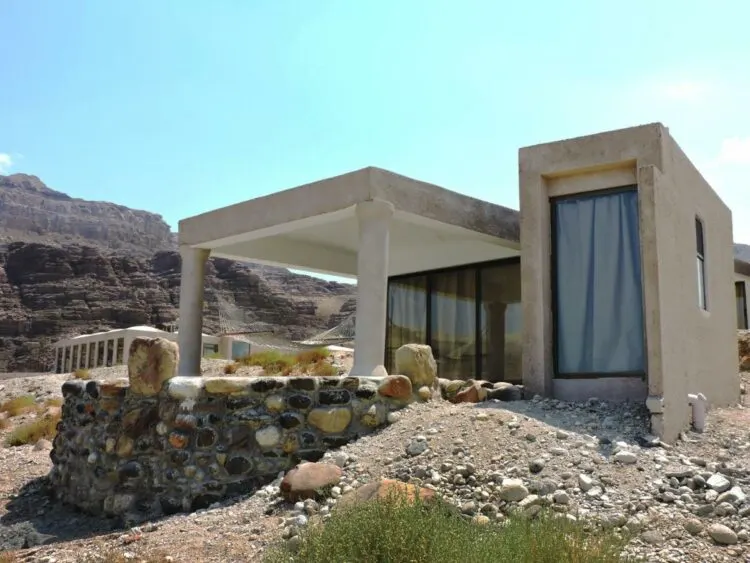
Wadi Mujib Chalets – close to the Wadi Mujib canyon and overlooking the Dead Sea
Another good option is to combine your visit to Wadi Mujib with a stay at one of the Dead Sea Resorts. Most are within 20-30 minutes drive of Wadi Mujib, offering a more luxurious resort experience.
We can recommend the following Dead Sea resorts, although they all offer a similar international style ambiance, so it’s worth shopping around for the best deals – check out all the Dead Sea Resorts here.
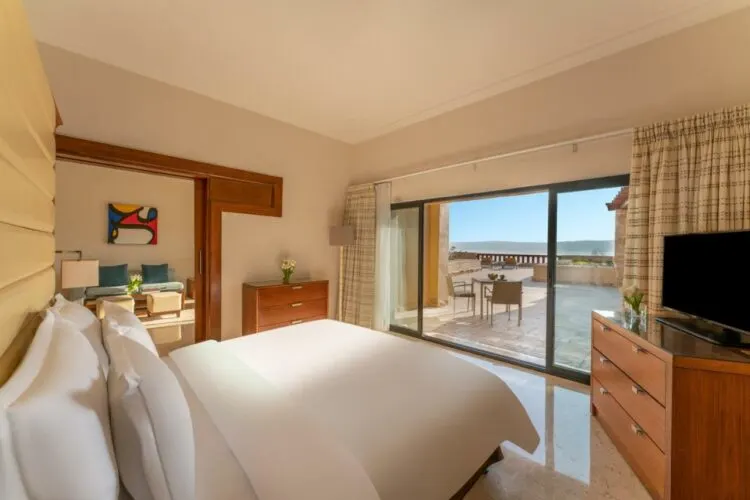
Mövenpick Resort & Spa is a 5-star Resort and Spa with panoramic views of the Dead Sea

The Holiday Inn Resort (where we stayed) sits at the edge of the Dead Sea and offers a private beach area

The Crowne Plaza Resort & Spa offers a resort experience overlooking the Dead Sea
More information to plan your trip
You’ll find more information to plan your trip on the following official tourism websites
- Visit Jordan Official Tourism Website
- Wild Jordan Official Website
Pin it!
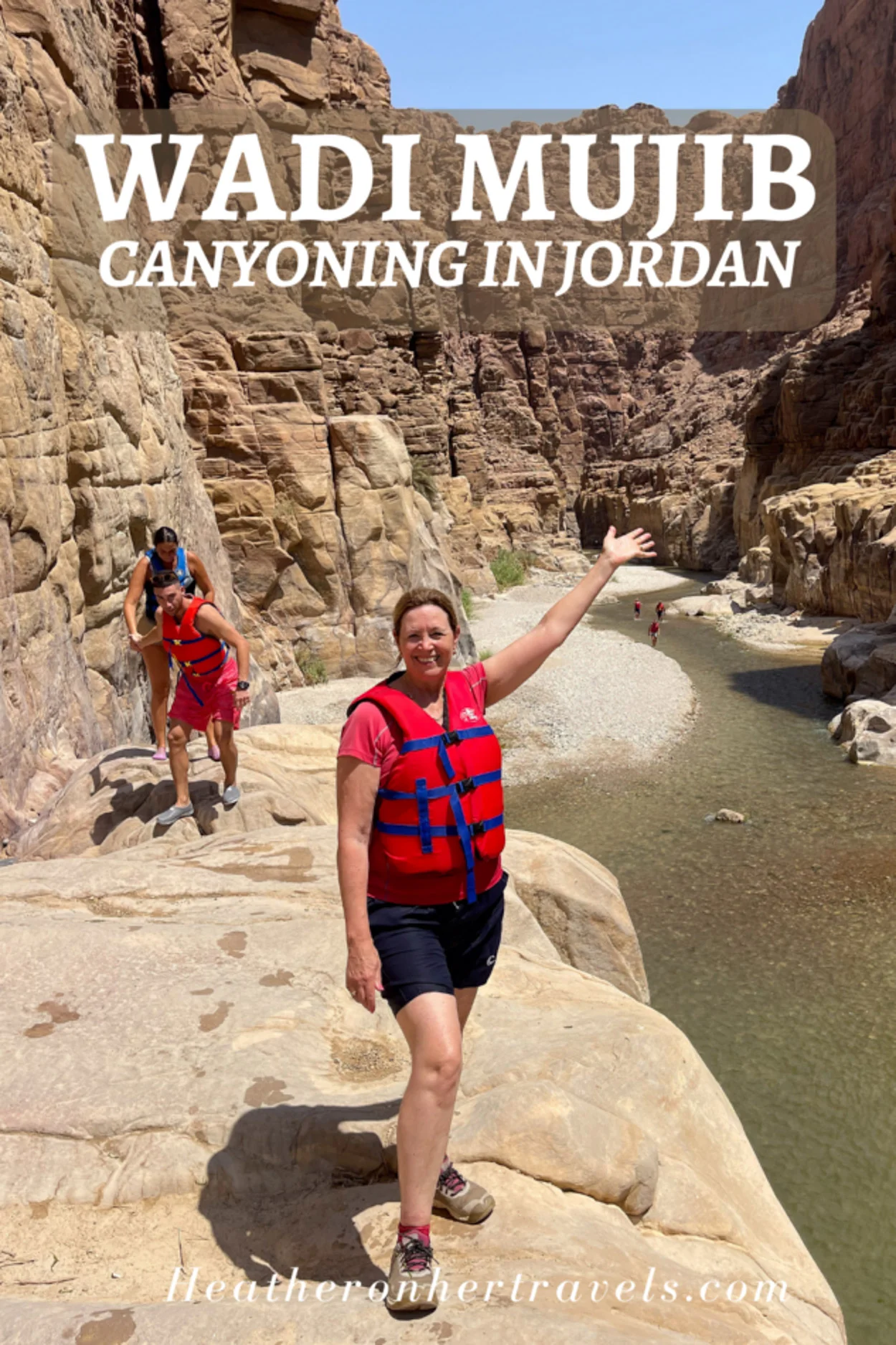
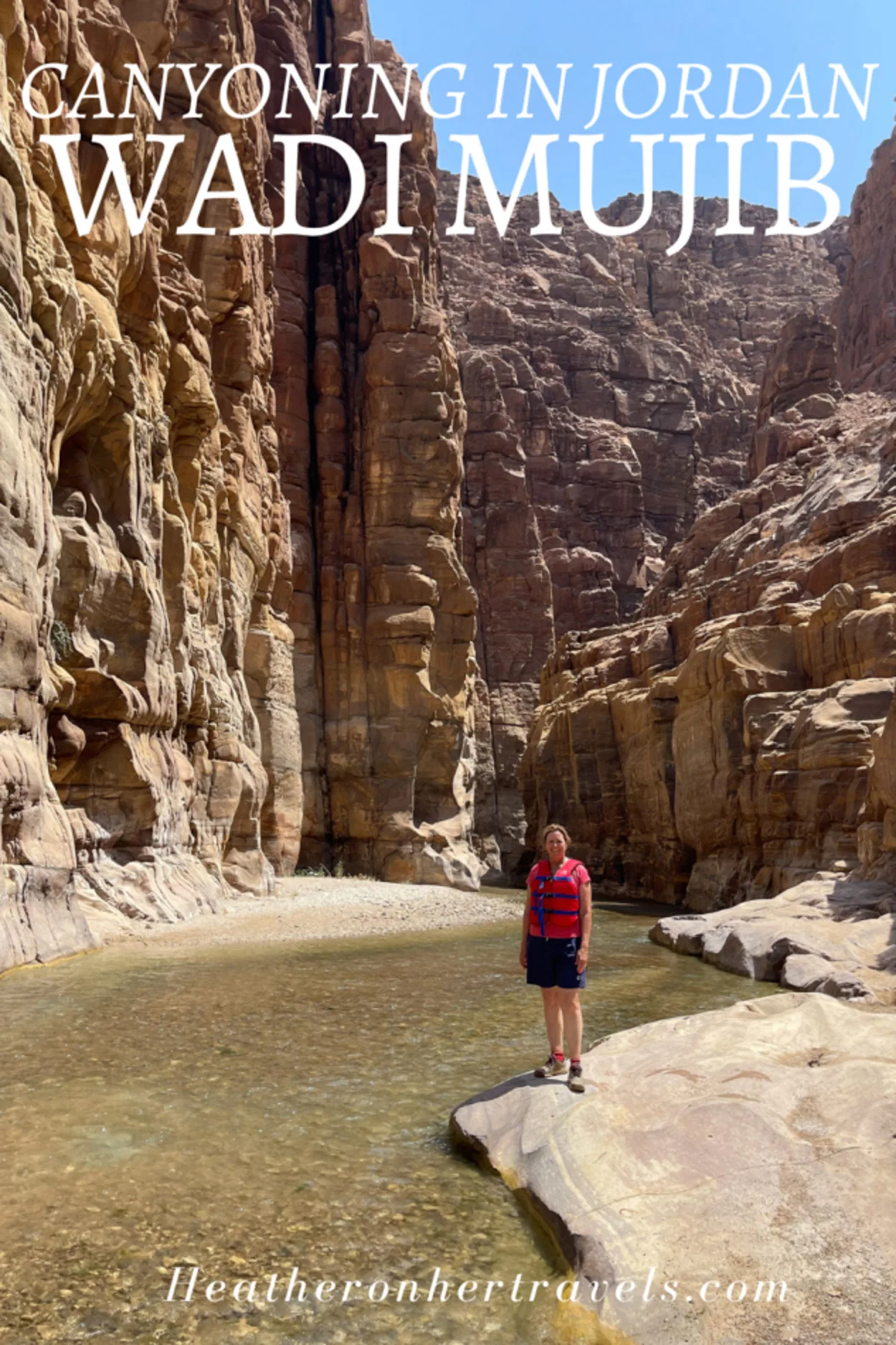
This article is originally published at Heatheronhertravels.com
Never miss an update! – Subscribe to receive our latest articles and newsletter
All photography and text in this article is Copyright to Heather Cowper / Heatheronhertravels.com and may not be reproduced without permission.



